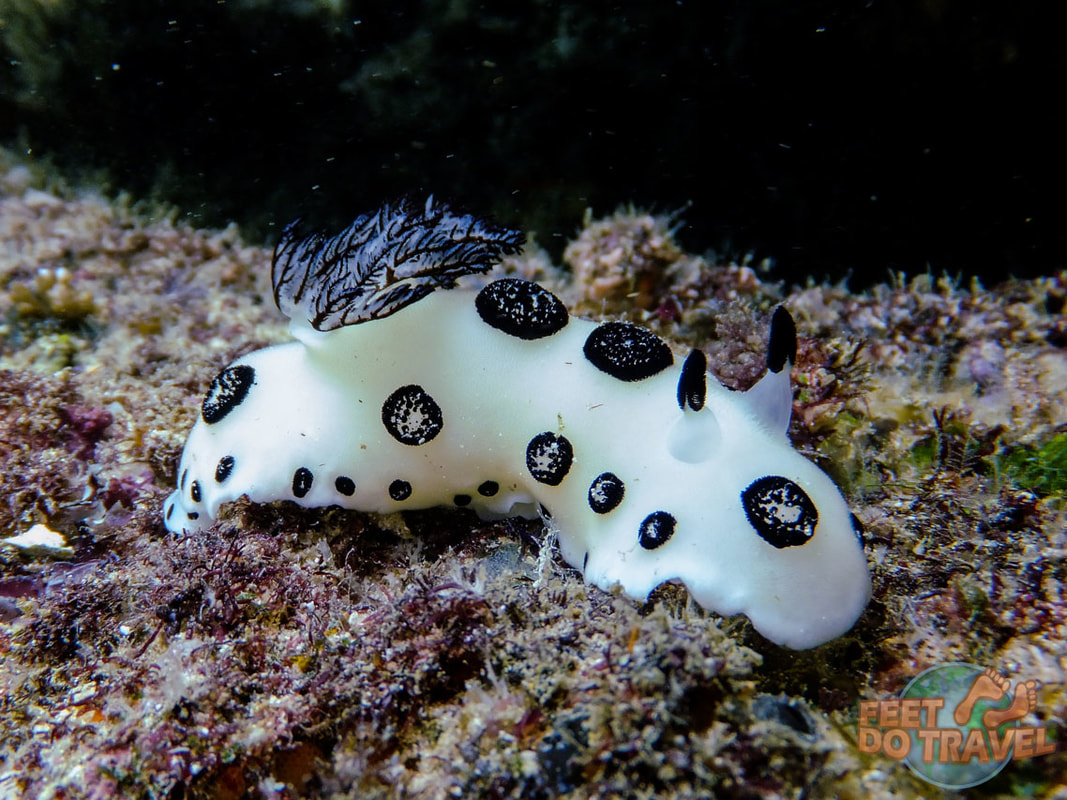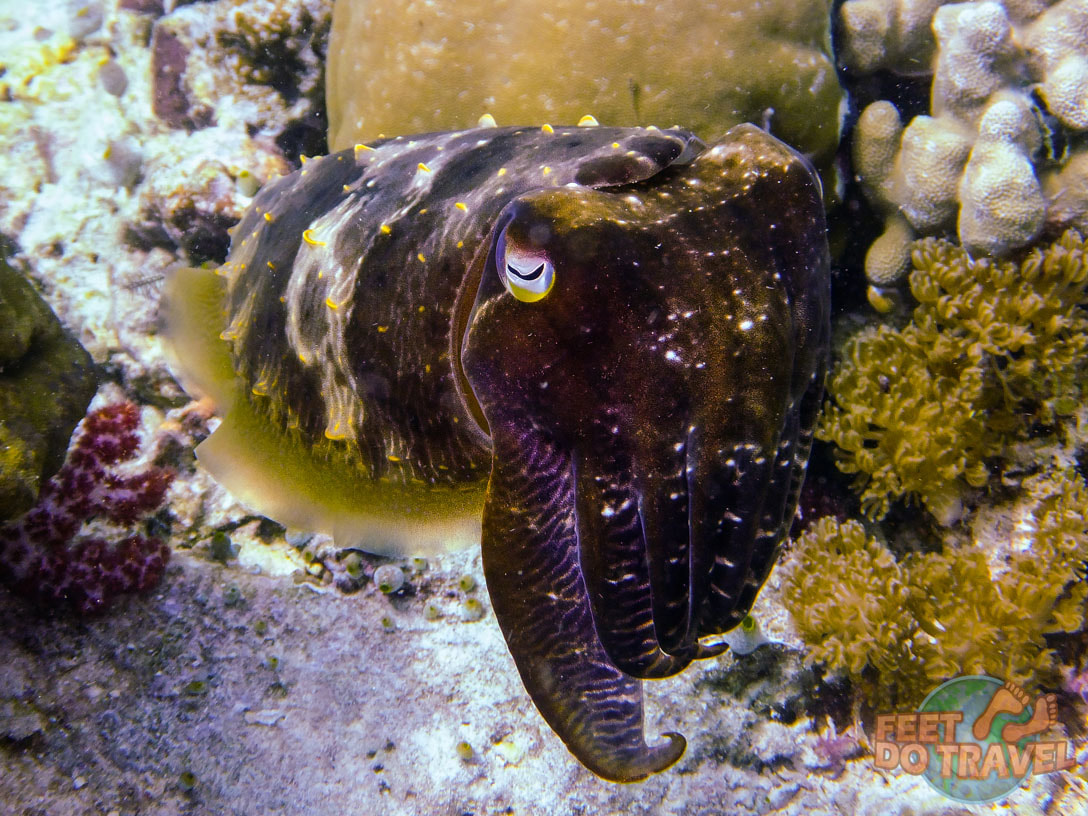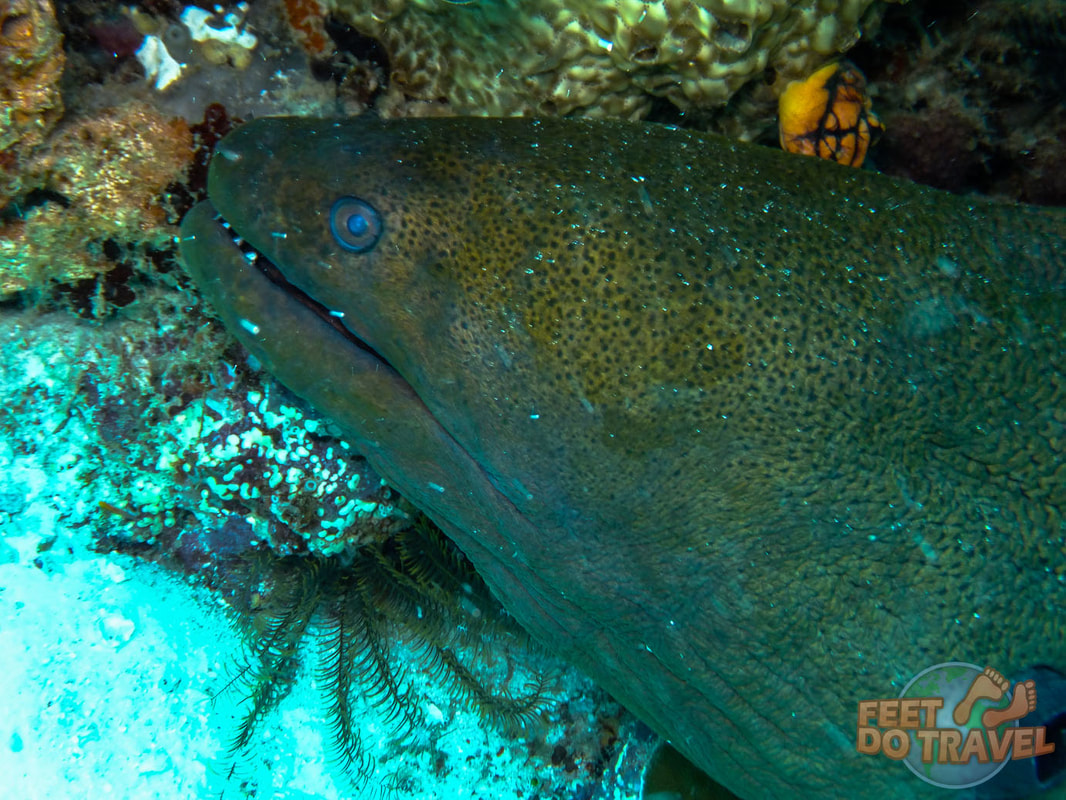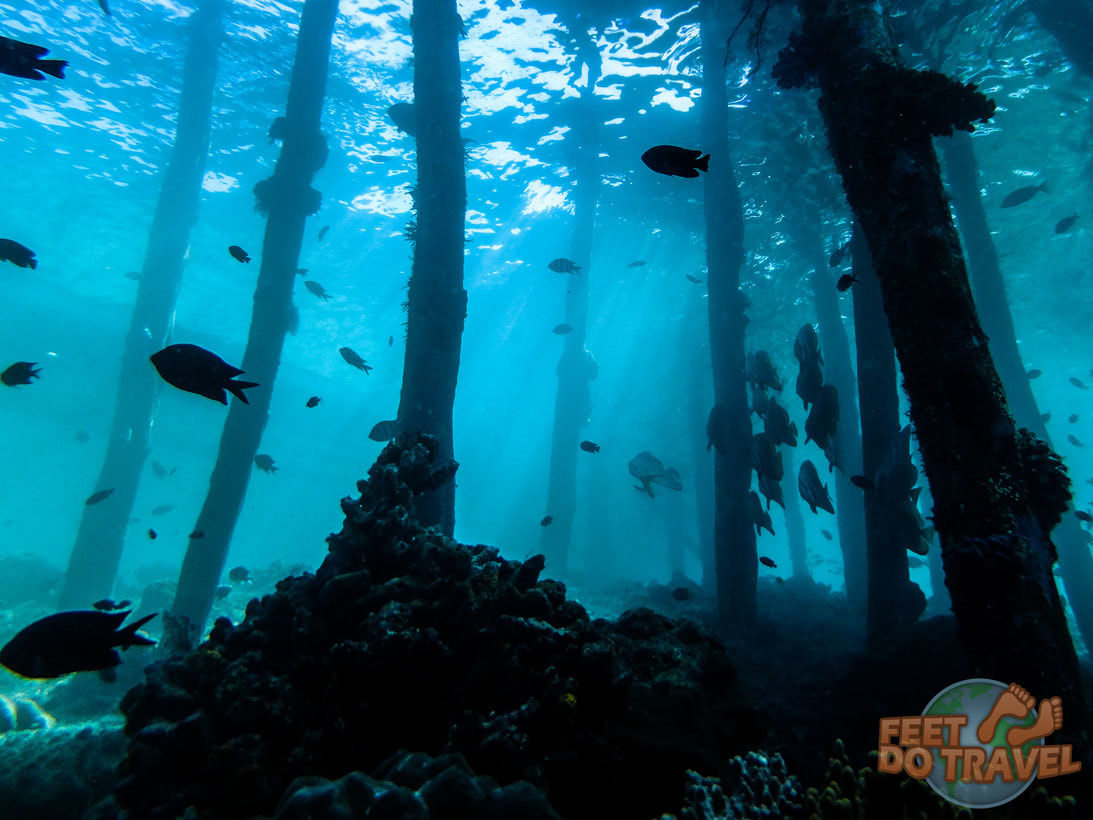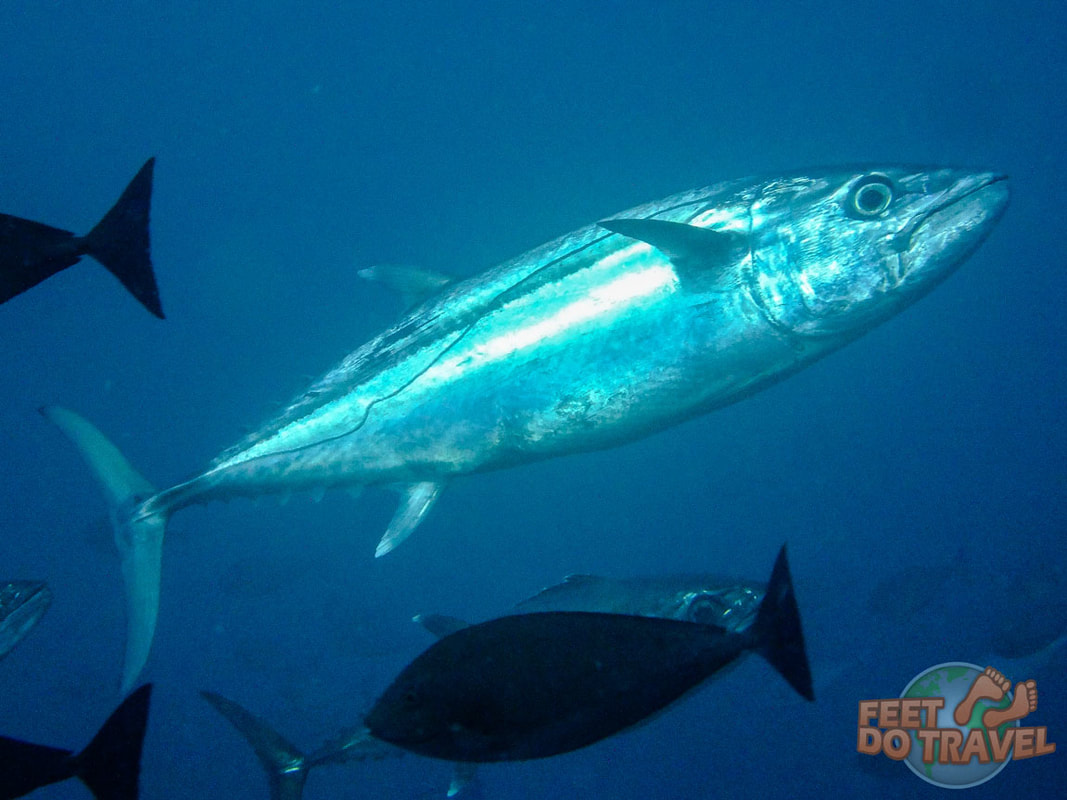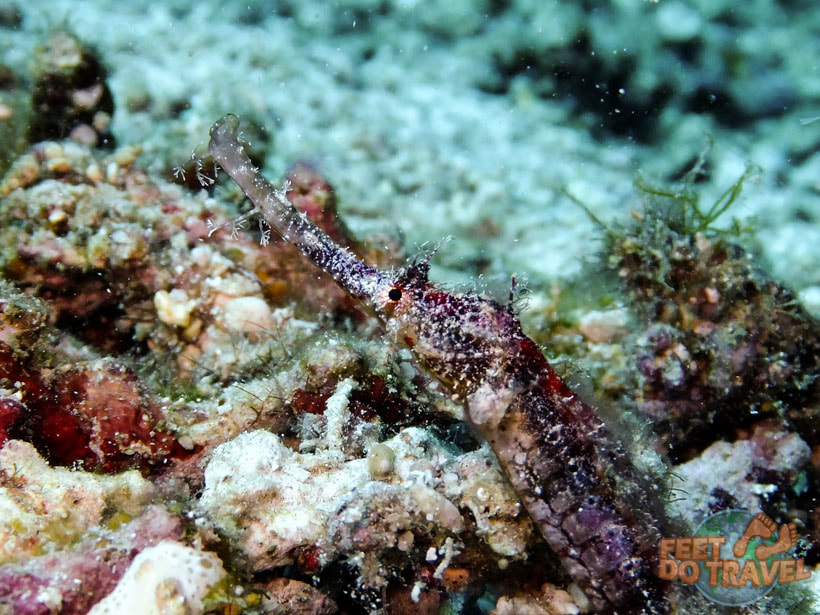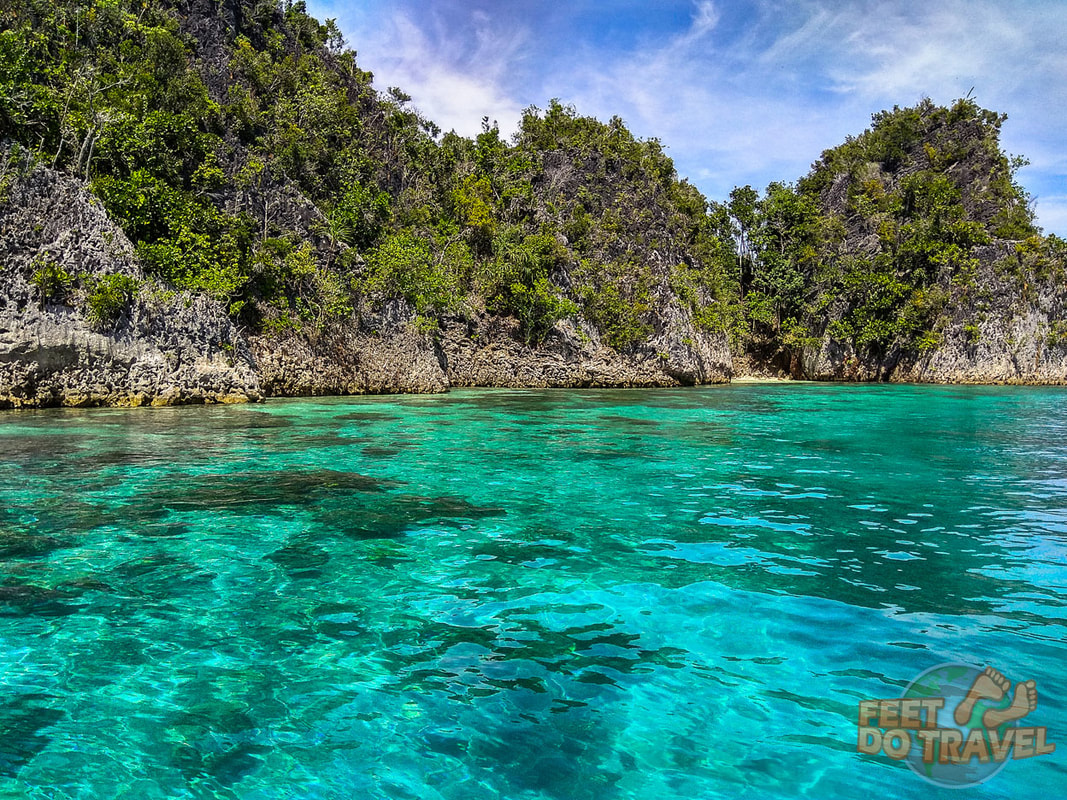
Dotted around are jagged karst limestone islands, little islets covered with lush trees, some have pure white sand beaches with palm tree fringed shores and others looked like they were floating on the surface. The views are simply stunning,
Raja Ampat is one of the world’s most famous regions for amazing scuba diving, freediving and snorkelling. We had heard stories of pristine coral gardens and prolific marine life so thick it blots out the sun, and that is why we wanted to visit.
We wanted to find out for ourselves if these stories were true or largely exaggerated.
Boy oh boy, what an experience we had!
|
Raja Ampat or “Four Kings” is made up of four main islands and approximately 1,500 smaller islands surrounding them. Located in the far east of Indonesia in the West Papua Province near Papua New Guinea, this archipelago is the world’s largest chain of islands spanning over 40,000 sq m, no wonder Indonesians refer to their country as “our land our water”.
Sitting between the Eurasian and Australian continental plates and the Philippine and Pacific Oceans, it’s in the heart of the Coral Triangle so the biodiversity is astounding. It’s the plankton rich water channelled here from all directions which gives this region such amazing beauty and diversity. |
Diving Raja Ampat isn’t all about the fish. The huge variety of coral formations provide a rainbow of colours. Apparently over 450 different species of coral have been recorded thriving here and at times, it honestly feels as though you are in an underwater forest. If coral reefs are the cities of the sea, this was the greatest of them all.
Basically, everything in Raja Ampat is done to excess.
Scuba Diving in Raja Ampat
Liveaboards are the most popular choice for diving but can cost a lot of money which is great if you can afford it, but it does mean that this region isn’t so accessible to everyone. Admittedly, Raja Ampat isn’t an easy travel destination, but paradise on earth should be difficult to reach otherwise it won’t remain paradise for too long. It’s worth the effort to get there and it is possible to stay and dive at a reasonable cost. We know, because we did it.
If a liveaboard isn’t an option for you, check out our post Raja Ampat on a Budget. This archipelago is huge and you will not cover all dive sites if you are staying on one island, however if you choose to stay off the north island of Waigo, there are around 30 excellent world-class sites to choose from. We stayed about 30 minutes away from Waigo so this post covers dives purely in the North.
Do note that most of Raja Ampat are Christian so it is advised not to book tours on a Sunday so locals can pray or attend Church.
The Water temperature is a year round average of 29°c. The best time to visit for visibility and marine life is October – April, however if you are after perfect conditions, choose mid-October to mid-December. Although Raja Ampat is famous for its currents, we visited during a half-moon and experienced hardly any at all on any of the dive sites. Obviously it’s not just the moon cycle which affects the currents but for the sake of disclosure, I am explaining our dive conditions.
Now, let me share with you our experience, of diving Raja Ampat!
|
Friwin Monday
As we dropped in we were surrounded by thousands of tiny fish and a pristine coral wall dropping down into the abyss. We swam around admiring the colours and the fish, then all of sudden I was surrounded by thousands upon thousands of rainbow runners dashing past turning the sky black, it was incredible. In the distance we spotted a shark then our guide pointed out nudibranchs, flatworms and shrimps, this dive site had it all. As we dived around admiring all the fish, we were aware of the pristine colourful coral rising up high and spreading out wide. Stunning. I remember thinking “welcome to Raja Ampat”. |
Whilst descending, we immediately saw two devil rays cruising above us and as I looked down, there was a pickhandle barracuda. Not a bad start. Suddenly we were surrounded by millions of silversides with around 10 more barracuda trying to decide on their next meal.
|
Cape Kri
This dive site is one of the most popular and one of the most requested. It’s the dive site that put Raja Ampat on the map when Dr Gerry Allen recorded a record number 374 different fish species seen on a single tank dive. I’m going to go out on a limb here and say that for me, there are better dive sites and there was nothing extra-ordinary here. Maybe I was spoilt by other dive sites, maybe it was because there was only a slight current so not as much marine life as when the famous strong currents are here, maybe we were simply taken to a part that wasn’t as great as other parts but either way, that is my personal opinion. |
There was still lovely coral (despite the fact that it was near this dive site where a cruise ship run aground on 4 March 2017). Marine life wasn’t too shabby either, we saw a small school of barracuda, Big Eye trevallies (Jackfish), pygmy seahorse, nudibranch, moray eel, white tip reef shark, flathead crocodile fish, huge sweetlips, so not exactly a bad site, as I said, maybe I had been spoilt.
The only way to describe this dive site is an underwater botanic garden with a kaleidoscope of colours, it was like looking at a rainbow and every colour was visible. The formations were stunning; bommies, pinnacles, table top, steep walls and crevasses, the whole site was a coral mountain. From what I have seen of 1960’s music documentaries, rock stars on LSD couldn’t even dream of seeing this many colours whilst tripping.
Melissa’s Garden
This dive site is a strong contender for the world’s best dive site (in my opinion) rivalling that of Sipadan, Komodo or Sangalaki. Every type of coral imaginable was to be seen, hard, soft, huge gorgonian fans, tables carpeted vast areas of the ocean floor and pristine coral structures rose up high. If you want to see an underwater botanical garden, then come to Melissa’s Garden and yes, the coral structures here were actually better than Mike’s Point which I didn’t think was possible!

Tuna, Napoleon Wrasse, Wobbegongs and schools of blue & yellow fusiliers, silversides, rainbow runners, scorpion fish, puffer fish and golden trevally. I only saw one of the 2cm tall Bargibani Pygmy seahorses tethered to a huge gorgonian fan but apparently they tend to live in clusters or pairs of which there are eight different known species. Next time, I will just have to look harder for its mate!
It was here I saw my first Oceanic Manta (Manta Birostis) just cruising slowly by. There were also four giant moray eels, crocodile flathead, Raggie Scorpionfish, cuttlefish, a huge napoleon wrasse, four wobbegongs, sweetlips and more pristine beautiful coral.
The dive finished at the jetty where schools of sergeant majors and batfish could be found hugging the pillars. As you may be able to tell from my description, I may appear less enthusiastic about this site but that is merely because I was exhausted with emotion when we dived here having just been to Melissa’s Garden so apologies for that. The photos will tell you the story of how good the dive was.
As we descended into the cobalt blue water, literally millions of fish filled our vision. Schools of big-eyed trevally (jacks), blue & yellow fusiliers, rainbow runners, silversides, Oxeye scads, pickhandle barracuda, huge dog-toothed tuna and giant trevally darted in and out; a vision of silver was all I could see. The sunlight streaked through providing a perfect silhouette of the millions of fish that live here.
As I looked up, an Oceanic Manta (Manta Birostis) was silhouetted with fish surrounding it. I thought that was the highlight, wow! That is until we saw the Manta slowly circling a coral pinnacle cleaning station. Around and around it glided effortlessly getting closer and closer to us. We watched in awe for around 30 minutes, we saw its eyes looking at us and its unique underbelly pattern. Even at our safety stop it continued to circle beneath us and we were able to see the markings on its back.
At the end of the dive, I was literally exhausted from permanent excitement. This site blew my mind, possibly the best dive ever and I will say, this (for me) was the most perfect dive site in Raja Ampat.
The fish and coral combination at this dive site make it popular with underwater photographers, it is often referred to as one of the best reef dives in the world and the best dive people have ever done. We dived here after Blue Magic and didn’t feel it quite met that standard and if we would have done the dive sites the other way around, this could be a different story. Maybe it’s because there was hardly any current we didn’t get quite the same amount of marine life as in reef-hook conditions and it is a shame that we didn’t have a chance to see the ball of sardines for which this site is famous for (that’s diving for you!). Either way, I apologise once again if I am lacking in enthusiasm, this really is a very good dive site!
What we did have is some nice black tip reef shark activity as they cruised through the coral reef, tuna, giant trevally, schools of blue & yellow fusilier, rainbow runners and pickhandle barracudas together with chevron barracudas were just hanging around eyeing up the schools almost as though they were picking out their dinner. Yellow masked angelfish, coral grouper, baba’s squat lobster living in a yellow feather star and a couple of pygmy seahorses, as you can tell, it really is a very good dive site!
Located between Mansuar and Arobek islands, as this namesake suggests it’s possible to find masses of manta rays, including the Oceanic (Giant) Manta Ray which have a wingspan of over 5 metres (as we saw on other sights). Sadly we didn’t see any mantas when we dove here, it was Sunday, maybe they had gone to church. This dive site without mantas is pretty uninteresting, it’s just sandy (as the name suggests) with small coral areas that comprise the Manta cleaning stations. To avoid our disappointment, we searched for macro but alas, without mantas this dive site didn’t deliver for us. NB We know people that dived here a few days later and they did see mantas so it’s all about your luck!
Piaynemo/Pianemo viewpoint
Described as heaven on earth, the quintessential image of Raja Ampat is the Piaynemo viewpoint. Once again I will go out on a limb and will say that it is the most beautiful vision I have ever encountered on all my travels (so far) around the world. Never have I seen with my own eyes a place so breathtaking. The contrast of jade pools surrounding jungle covered islets dotted in the cobolt blue sea is indescribable, the vision is surreal. If you visit Raja Ampat and have an option to come to this viewpoint – TAKE IT!
Do note that you will need to walk up about 350 wooden steps to reach the top but oh boy, it is 110% worth it! At the bottom, you can buy a fresh coconut for just 15,000 IDR, a cheap and exotic way of rehydrating yourself. Sit down, sip on your coconut and marvel at the beauty that is all around you (feel free to pinch yourself if you don’t believe what you are seeing is real).
How to get to Raja Ampat … in a nutshell
- Domestic flight to Sorong, the main airport in Raja Ampat
- Taxi from Sorong airport to the port (10-15 minutes)
- Ferry from Sorong to Wasai (2 – 2.5 hours). Note: you can also fly Sorong to Wasai.
- Speedboat transfer from Wasai to your accommodation, most Liveaboards, Dive Resorts and homestay operators will pick you up (30-60 minutes)
Note: There are no international flights to Raja Ampat. It’s on the Eastern Indonesian Time Zone (GMT +9 hours), please be aware of this when booking flights.
For more detail on how to get to Raja Ampat, choosing which island and accommodation, please read Raja Ampat on a budget.
A Marine Park Entry Permit will need to be purchased for 1,000,000 IDR (it's valid for 12 months). Some resorts will pre-purchase them on behalf of guests but if you are staying with a homestay, you can easily buy them yourself in Sorong or, as we did, at Wasai Harbour.
It is possible to find a very bad dive centre in Raja Ampat, one that has questionable safety standards, lack correct equipment maintenance, have unhealthy air in their tanks and have the attitude to deny these health factors exist. We found out the hard way.
Online research via the excellent Stay Raja Ampat website led us to Daroyen Village on Gam, their reviews certainly weren’t bad and the communication in advance led us to believe we had chosen well. We were wrong.
Our dream of diving in paradise quickly turned into a nightmare as soon as we started gearing up on the boat (the staff hadn’t checked equipment in advance and all sorts of failures were discovered just before our first) and. By the end of the day we all had headaches and felt unwell the next day due to breathing contaminated air. What was even more concerning, was their efforts to dismiss our concerns and attempts to discredit us with inaccuracies on the Stay Raja Ampat website. Sadly, it appears that not just the equipment needs addressing but their attitude towards safety.
Two days out of seven were ruined but thankfully I had done quite a bit of research in advance and had a few other options. Kordiris Homestay (30 minutes boat ride away) were our knights in shining armour and luckily had space in their accommodation. They picked us up by boat, took us to their homestay and we dived the remainder of our stay with them. What a god-send, we were able to jump on an afternoon dive so we hadn’t lost another whole day.
I am sorry to say that our first three dives in Raja Ampat were a huge disappointment (so I have only mentioned one in this post, Manta Sandy). Aside from multiple issues of faulty equipment and breathing contaminated air, we were guided in a reciprocal line there and back over crushed and dead coral – I did not come all the way to Raja Ampat to see huge areas of dead coral when it’s a place famous for its pristine coral reefs and swim-throughs. We certainly didn’t want to follow someone that didn’t appear to know the sites! We could have dived our own reciprocal line, what we expected (and were paying for) was local knowledge of sites and marine life.
A bad dive centre can ruin your holiday, it almost ruined ours, it could also put your life at risk. Since our experience, we have learned that others felt the same and reviews have been left accordingly. It is a shame that (so far) they appear to have refused to believe the serious concerns raised.
Dive Guides will set up your equipment and help you into it, take you to the sites, guide you around pointing out marine life and bring you back up again not necessarily with a safety stop or SMB, you will also have to keep an eye on your own depth limits and air consumption. If you are happy with this, you will have more options to choose from. As Sy is a Dive Instructor this was fine for us so we did our own buddy checks and followed the diving guidelines we have been taught. If you use a dive centre that isn’t PADI/SSI affiliated, I would recommend you take an SMB as mandatory (and learn/know how to use it), even if you don’t have any other equipment.
If you have your own equipment, you may want to enquire first as to whether they have basic washing facilities to help with maintenance of your gear. At Daroyen Village they didn’t; both Sy’s own equipment and the rental gear were pulled out of the ocean and hung up to dry without the bear minimal of a quick dunk; not even a wash of regulators for the next person to use. A reputable dive centre will have somewhere to wash your gear which obviously helps towards equipment maintenance.
The most recommended word of mouth dive centre is Papua Diving who are a PADI 5* resort at Kri Eco Resort (you don’t have to stay at the resort to dive with them but you may need to stay on the island of Kri where there is plenty accommodation to choose from). According to Trip Advisor, the Number 1 Dive Resort is Papua Explorers Resort .The best dive local centre that isn't a resort (according to Trip Advisor) is Arborek Dive Centre on the island of Arborek. Please note, reports state they are excellent Rescue Divers and not DM’s, however they have been diving here for many years so are very familiar with the area and its currents. There are six Homestays on Arborek to choose from for your stay, all charge the same price.
Kordiris Homestay & Dive centre – our knight in shining armour
Kordiris is a basic homestay and dive centre where they have dive guides and not PADI/SSI Dive Masters as mentioned above. This isn’t a criticism I am merely stating the fact so you know what to expect and we were fine with that. Their equipment was in good condition and they have two dunk tanks for washing afterwards.
Sitting at the dining room or on the jetty, we saw baby day octopus, blue spotted stingray, broad club cuttlefish and snowflake moray eels. At dusk, small black tip reef sharks cruise underneath. Birds of paradise can be heard high in the trees and you may catch a Cuscus sleeping or munching on leaves.
Kordiris showed us that you can stay and dive the magnificent Raja Ampat on a budget.
Decompression Chamber – Dr Irwanto +62 813 4413 0764
Doctor (General Practitioner) – Dr Arief +62 813 4498 8155
Search & Rescue Agency (Wasai) +62 812 8142 5228
Search & Rescue Agency (Sorong) +62 951 323816
Navy Base (Sorong) +62 951 321789
General Hospital (Sorong) +62 951 321763 or +62 951 321850
Water police (Wasai) +62 813 4454 9664
Police station (Sorong Precinct) +62 951 321855
Health & Safety
Dehydration – You can lose up to a litre of water per dive just by breathing the compressed air so drink plenty of fluids! Fresh coconut is one of the best options for rehydration as it grows in most parts of Raja Ampat
Wounds and infections – Cuts can easily become infected in the tropics so clean and treat even the smallest of wounds immediately, especially reef cuts
Malaria – This unfortunately exists in Raja Ampat and mosquitos are more prominent in mangrove areas. Consult your doctor prior to travels and protect yourself by covering up and using mosquito repellent
Sunburn – Raja Ampat is in the tropics and the sun can burn you, even on a cloudy day! Wear reef-friendly sunscreen, cover up, wear a hat and drink plenty of fluids
What to take with you
- For scuba divers, it's advisable to have your own SMB and maybe a reef hook (but do not hook into coral, only rock!)
- An underwater torch for night dives or swim-throughs
- A refillable water bottle (essential to maintain fluid intake)
- Paracetamol (or similar)
- Mosquito repellent
- Tiger balm or some other anti-itch mosquito cream
- Germoline or similair antiseptic cream .. just in case
- Any first aid or medication you may need as there are no shops on the small islands
Travel facts
- The official currency is Indonesian Rupiah’s (IDR)
- A 30 day visa is given at the time of arrival (not for all countries, check with your embassy) but if you want to stay longer in Indonesia, you can obtain a 60 day visa in advance at consulates and embassies.
- There are no ATM’s on any of the small islands so you may need to ensure you take plenty of cash to pay for your accommodation, transfers and activities. Some places do accept credit cards (some apply a small charge) so speak with your accommodation in advance.
- There is no wi-fi or internet in homestays so if you want data, buy a SIM card at the airport. Some of the resorts do have internet so check with them first.
- Sunday is a religious day so there may not always be transfers.
- Dress appropriately - it is not polite to walk around or sit at dinner wearing bathing suits just because it is hot! Locals may not say anything but they have told the Stay Raja Ampat website that this issue is very important.
- English isn't widely spoken so please bear this in mind. Bahasa Indonesian is widely understood, but most people use one of the many Papuan languages.
- If you can use just a couple of Indonesian words, this will give you big smile in return, even if you simply use “Pagi” (morning) and “Terima Kasih” (thank you), it will be hugely appreciated.
Have you been to Raja Ampat? Did you do a liveaboard, Dive Resort or Homestay? Which was your favourite dive site? Tell us in the comments below. If you plan to visit, please let us know in the comments section if this guide and our “Raja Ampat on a Budget” have been useful to you.

Book your next hotel through our website as we have an affiliate partnership with Booking.com. Visit our Hotel Booking Page and search as normal. It won’t cost you any extra but you will be helping to keep FeetDoTravel running.

Nusa Penida: Diving with Mola Mola, the Ocean Sunfish
Scuba Diving the Gili Islands
Manta Madness
Lembeh - A Magical Muck Diving Experience
USS Liberty in Bali - Highly Wreck-Ommended
Travelling around Indonesia? Hope these links help!
Raja Ampat on a Budget
Lembongan - Bali, but Better!
15 Things To Do In Canggu, Bali
Gili Air - The Perfect Island?
World Oceans Day: Conservation Success on Gili Air
Volunteering at Gili Air Cat Clinic
Gili Trawangan - Not Just A Party Island
Gili Meno - The Island of Love
10 Must Try Indonesian Dishes
Gili Gede - The Secret Gili Islands
Gili Asahan - The Secret Gili Islands
Gili Sudak and Gili Kedis - The Secret Gili Islands
Kuta Lombok - The New Kuta Bali?
Is Pink Beach Lombok Worth Visiting?
Wonderful Waterfalls of Lombok
Tarsiers and a Monkey Selfie
Komodo Dragon Hike in Rinca
Komodo, Flores, More Than Just Dragons
Jewels of Java - Borobudur & Prambanan
Indonesian Orangutan Adventure
Derawan & Sangalaki - Borneo's Hidden Gem?
The #FeetDoTravel blog link-up!
We are proud to host the #FollowMeFriday blog Linkup. If you have a blog post you would like to share, feel free to click on the picture below which will take you through to our Facebook Community and drop your link there. The link-up is open from 3am Friday morning (UK time) and will close 8pm UK time Sunday. We are a fun and loyal group who are more than happy to comment, share and reciprocate! Happy Travelling Feet Fans!













